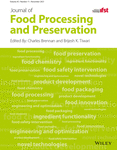Establishment of an oral processing model for three varieties of rice
Sailimuhan Asimi and Ren Xin contributed equally to this work and should be considered co-first authors.
Abstract
The objective of this study was to establish an oral processing model of cooked rice. Principal component analysis and orthogonal partial least squares discriminant analysis were performed to determine the main factors of cooked rice in different oral processing stages. The results of our study suggest that the textural properties and water content (dry wt basis) of the rice bolus are the main factors in determining the type of oral processing model. Specifically, the factors influencing the swallowing of Japonica rice include the chewing time, chewing number, cohesiveness, and water content. The factors influencing the swallowing of Glutinous rice include chewing time, chewing number, particle size, and water content, while those for Indica rice include chewing time, chewing number, and cohesiveness. In conclusion, Japonica rice showed semi-solid food characteristics during oral processing, while Glutinous rice and Indica rice showed soft solid food characteristics during oral processing.
Practical applications
This study will provide guidance method for establishing of other food oral processing models. In addition, it can provide theoretical support for the selection of better rice products from the perspective of oral processing.
CONFLICT OF INTEREST
The authors have declared no conflicts of interest for this article.
Open Research
DATA AVAILABILITY STATEMENT
All data included in this study are available upon request by contact with the corresponding author.
Ethical Review: This study was approved by the Institutional Review Board of China Agricultural University. Informed Consent: Written informed consent was obtained from all study participants.




